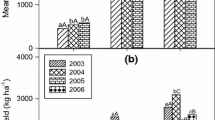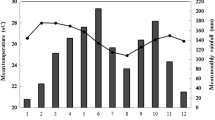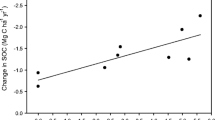Abstract
Declines in soil fertility and limited access to inorganic nitrogen (N) fertilizer constrain crop production in Sub-Saharan Africa. The incorporation of organic residues could increase nutrient mineralization and replenish soil carbon (C), however, the effect that long-term residue management (10+ years) has on maize (Zea mays L.) yields and soil nutrient pools (C and N) is largely unknown. In four identical long-term trials in Kenya that differ by soil type and climate, we compared maize yield and soil C (0–0.15 m) across four treatments comparing organic inputs of contrasting C:N ratios: tithonia [Tithonia diversifolia (Hemsl.) A. Gray] + N (120 kg N ha−1); tithonia − N (0 kg N ha−1); maize stover + N (120 kg N ha−1); maize stover − N (0 kg N ha−1). On average, maize yields were 92% greater under tithonia compared to maize stover at the sandy sites and in general followed this trend: tithonia + N > tithonia − N = stover + N > stover − N. The continuous application of tithonia also increased soil C and N pools; for instance, mineralizable C was up to 57% greater than that of maize stover at the sandy sites. Increases in yield and nutrient pools under tithonia were less apparent at the clay sites. When exploring the relationship between soil C and maize yield, we found that both mineralizable and processed pools were related to agronomic performance. Our findings demonstrate that low C:N residues could significantly benefit crop production and enhance soil organic matter at sandy sites across Kenya.



Similar content being viewed by others
References
Cambardella C, Elliot E (1992) Particulate soil organic-matter changes across a grassland cultivation sequence. Soil Sci Soc Am J 56:777–783. https://doi.org/10.2136/sssaj1992.03615995005600030017x
Cates AM, Ruark MD (2017) Soil aggregate and particulate C and N under corn rotations: responses to management and correlations with yield. Plant Soil 415:521–533. https://doi.org/10.1007/s11104-016-3121-9
Chivenge P, Vanlauwe B, Gentile R, Wangechi H, Mugendi D, van Kessel C, Six J (2009) Organic and mineral input management to enhance crop productivity in Central Kenya. Agron J 101:1266–1275. https://doi.org/10.2134/agronj2008.0188x
Combs M, Nathan MV (1998) Soil organic matter. In: Nathan M, Gelderman R (eds) Recommended chemical soil test procedures for the North Central Region. North Central Regional Research Publication No. 221 (Revised 2015). Missouri Agricultural Experiment Station SB 1001. Chap. 12. University of Missouri, Columbia, MO
Culman SW, Snapp SS, Freeman MA, Schipanski ME, Beniston J, Lal R, Drinkwater LE, Franzluebbers LJ, Glover JD, Grandy AS, Lee J, Six J, Maul JE, Mirksy SB, Spargo JT, Wander MM (2012) Permanganate oxidizable carbon reflects a processed soil fraction that is sensitive to management. Soil Sci Soc Am J 76:494–504. https://doi.org/10.2136/sssaj2011.0286
Culman SW, Snapp SS, Green JM, Gentry LE (2013) Short- and long-term labile soil carbon and nitrogen dynamics reflect management and predict corn agronomic performance. Agron J 76:493–502. https://doi.org/10.2134/agronj2012.0382
Franzluebbers AJ, Haney RL, Honeycutt CW, Schomberg HH, Hons FM (2000) Flush of carbon dioxide following rewetting of dried soil relates to active organic pools. Soil Sci Soc Am J 64:613–623. https://doi.org/10.2136/sssaj2000.642613x
Gentile R, Vanlauwe B, Chivenge P, Six J (2011a) Trade-offs between the short and long-term effects of residue quality on soil C and N dynamics. Plant Soil 338:159–169. https://doi.org/10.1007/s11104-010-0360-z
Gentile R, Vanlauwe B, Six J (2011b) Litter quality impacts short- but not long-term soil carbon dynamics in soil aggregate fractions. Ecol Appl 21:695–703. https://doi.org/10.1890/09-2325.1
Grandy AS, Neff JC (2008) Molecular C dynamics downstream: the biochemical decomposition sequence and its impact on soil organic matter structure and function. Sci Total Environ 404:297–307
Haney RL, Hons FM, Sanderson MA, Franzluebbers AJ (2001) A rapid procedure for estimating nitrogen mineralization in manured soil. Biol Fertil Soil 33:100–104. https://doi.org/10.1007/s003740000294
Hurisso TT, Culman SW, Horwath WR, Wade J, Cass D, Beniston JW, Bowles TM, Grandy AS, Franzluebbers AJ, Schipanski ME, Lucas ST, Ugarte CM (2016) Comparison of permanganate-oxidizable carbon and mineralizable carbon for assessment of organic matter stabilization and mineralization. Soil Sci Soc Am J 80:1352–1364. https://doi.org/10.2136/sssaj2016.04.0106
Hurisso TT, Moebius-Clune D, Culman SW, Moebius-Clune B, Thies JE, van Es HM (2018) Soil protein as a rapid soil health indicator of potentially available organic nitrogen. Agric Environ Lett. https://doi.org/10.2134/ael2018.02.0006
Jama B, Palm CA and Buresh RJ (1999) Using tithonia and fertilizers on maize in western Kenya. Maseno Agroforestry Research Centre Newsletter, ICRAF, Nairobi, Kenya. Mitini Maendeleo, vol 6, pp 3–4
Johnston AE, Poulton PR, Coleman K (2009) Soil organic matter: its importance in sustainable agriculture and carbon dioxide fluxes. Adv Agron 101:1–57. https://doi.org/10.1016/S0065-2113(08)00801-8
Kihara J, Nziguheba G, Zingore S, Coulibaly A, Esilaba A, Kabambe V, Njoroge S, Palm C, Huising J (2016) Understanding variability in crop response to fertilizer and amendements in sub-Saharan Africa. Agric Ecosyst Environ 229:1–12. https://doi.org/10.1016/j.agee.2016.05.012
Lal R (2004) Soil carbon sequestration impacts on global climate change and food security. Science 304:1623–1627. https://doi.org/10.1126/science.1097396
Lehmann J, Kleber M (2015) The contentious nature of soil organic matter. Nature 528:60–68. https://doi.org/10.1038/nature16069
Leifeld J, Kögel-Knabner I (2005) Soil organic matter fractions as early indicators for carbon stock changes under different land-use? Geoderma 124:143–155. https://doi.org/10.1016/j.geoderma.2004.04.009
Mehlich A (1984) Mehlich 3 soil test extractant: a modification of the Mehlich 2 extractant. Commun Soil Sci Plant Anal 15:1409–1416. https://doi.org/10.1080/00103628409367568
O’Rourke SM, Angers DA, Holden NM, McBratney AB (2015) Soil organic carbon across scales. Glob Change Biol. https://doi.org/10.1111/gcb.12959
Palm CA, Gachengo CN, Delve RJ, Cadisch G, Giller KE (2001) Organic inputs for soil fertility management in tropical agroecosystems: application of an organic resource database. Agric Ecosyst Environ 83:27–42. https://doi.org/10.1016/S0167-8809(00)00267-X
Rasse DP, Rumpel C, Dignac MF (2005) Is soil carbon mostly root carbon? Mechanisms for a specific stabilization. Plant Soil 269:341–356. https://doi.org/10.1023/A:1004343122448
R Core Team (2017) R: a language and environment for statistical computing. https://www.R-project.org/
Sanchez PA (2002) Soil fertility and hunger in Africa. Science 295:5562
Sedogo L, Konate G (2012) Preface. P. v-vi. In: Bationo A, Waswa B, Kihara J, Adolwa I, Vanlauwe B, Saidou K (eds) Lessons learned from long-term soil fertility management experiments in Africa. Springer, Dordrecht
Sikora FJ (2006) A buffer that mimics the SMP buffer for determining lime requirement of soil. Soil Sci Soc Am J 70:474–486
Smith P (2004) How long before a change in soil organic carbon can be detected? Glob Change Biol 10:1878–1883. https://doi.org/10.1111/j.1365-2486.2004.00854.x
Tully K, Wood SA, Almaraz M, Neilil C, Palm K (2015) The effect of the African Green Revolution interventions on yields and nitrogen balances in smallholder maize farms in western Kenya. Agric Ecosyst Environ 214:10–20. https://doi.org/10.1016/j.agee.2015.08.006
Vanlauwe B, Gachengo CN, Shepherd K, Barrios E, Cadisch G, Palm CA (2005) Laboratory validation of a resource quality-based conceptual framework for organic matter management. Soil Sci Soc Am J 69:1135–1145. https://doi.org/10.2136/sssaj2004.0089
Vanlauwe B, Bationo A, Chianu J, Giller KE, Merckx R, Mokwunye U, Ohiokphehai O, Pypers P, Tabo R, Shepherd KD, Smaling EMA, Woomer PL, Sanginga N (2010) Integrated soil fertility management: operational definition and consequences of implementation and dissemination. Outlook Agric 39:17–24. https://doi.org/10.5367/000000010791169998
Wander M (2004) Soil organic matter fractions and their relevance to soil function. In: Magdoff F, Weil RR (eds) Soil organic matter in sustainable agriculture. CRC Press, Boca Raton, pp 67–102
Weil RR, Islam KR, Stine MA, Gruver JB, Samson-Liebig SE (2003) Estimating active carbon for soil quality assessment: a simplified method for laboratory and field use. AM J Altern Agric 18:3–17. https://doi.org/10.1079/AJAA200228
Wood SA, Sokol N, Bell CW, Bradford MA, Naeem S, Wallenstein MD, Palm CA (2016) Opposing effects of different soil organic matter fractions on crop yields. Ecol Appl 26:2072–2085. https://doi.org/10.1890/16-0024.1
Acknowledgements
We thank professors Monicah Mucheru and Daniel Mugendi, in addition to the technical staff at TSBF-CIAT Nairobi for the maintenance of the field trials. We also thank Bethany Herman, Stuti Sharma, and Phoo Zone for their assistance with laboratory analyses. Finally, we thank two anonymous reviewers for their insightful and constructive feedback. This research was supported by the National Science Foundation (DEB: 0344971) and a National Science Foundation Post-doctoral Research Fellowship (Award No: 1523821).
Author information
Authors and Affiliations
Corresponding author
Additional information
Publisher's Note
Springer Nature remains neutral with regard to jurisdictional claims in published maps and institutional affiliations.
Electronic supplementary material
Below is the link to the electronic supplementary material.
Rights and permissions
About this article
Cite this article
Sprunger, C.D., Culman, S.W., Palm, C.A. et al. Long-term application of low C:N residues enhances maize yield and soil nutrient pools across Kenya. Nutr Cycl Agroecosyst 114, 261–276 (2019). https://doi.org/10.1007/s10705-019-10005-4
Received:
Accepted:
Published:
Issue Date:
DOI: https://doi.org/10.1007/s10705-019-10005-4




